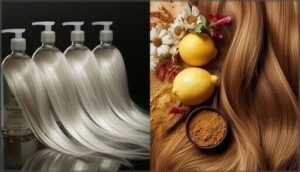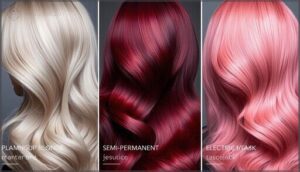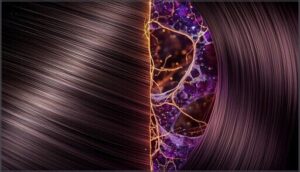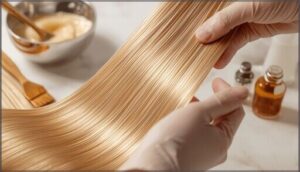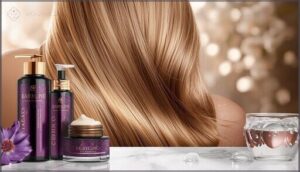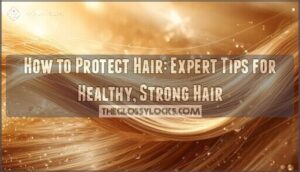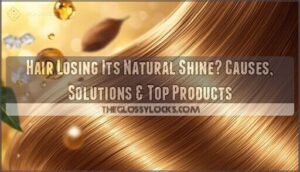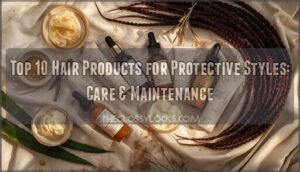This site is supported by our readers. We may earn a commission, at no cost to you, if you purchase through links.
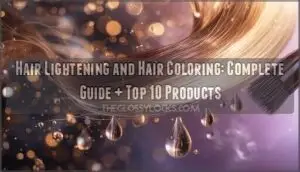
When you bleach your hair, hydrogen peroxide breaks down the pigments that give it color, forcing open the cuticle to strip away what’s naturally there.
Hair dye works differently—it either sits on top for temporary color or uses ammonia to push permanent pigments deep into your hair’s core.
Whether you’re bleaching or dyeing, your hair takes a beating and needs extra TLC afterward.
The smart move is picking the right method for what you want while keeping your hair healthy with gentle, nourishing products.
Table Of Contents
- Key Takeaways
- Hair Structure and Growth Explained
- How Hair Lightening and Coloring Work
- Safe Hair Lightening Methods and Precautions
- Essential Hair Care Tips for Color-Treated Hair
- Top 10 Hair Products for Lightening and Coloring
- 1. Purple Toning Conditioner For Blondes
- 2. clarifying shampoo for oily hair
- 3. Redken Moisture Restore Hair Treatment
- 4. Hyaluron Plump Hydrating Shampoo Care
- 5. Biolage Strength Recovery Hair Care
- 6. Strength Cure Shampoo And Conditioner
- 7. Nexxus Root Lift Thickening Spray
- 8. Anti Frizz Hair Styling Cream
- 9. Shark FlexStyle Hair Drying System
- 10. Clairol Medium Blonde Hair Dye
- Frequently Asked Questions (FAQs)
- What type of bleaching products are best to use?
- How often should I use a hair lightening solution?
- Is it safe to use hydrogen peroxide on my hair?
- How long does it take for hair to lighten naturally?
- How often should I touch up roots?
- Can I lighten dark hair without bleach?
- What causes hair color to fade quickly?
- Is box dye safer than salon coloring?
- How long should I wait between coloring sessions?
- Conclusion
Key Takeaways
- You’ll damage your hair’s structure when bleaching breaks down melanin and weakens protein bonds, so always do strand tests and wait 4-6 weeks between sessions to let your hair recover properly.
- Your color-treated hair needs sulfate-free shampoos and deep conditioning treatments since chemical processing makes strands more porous and vulnerable to breakage and color fading.
- You can choose between permanent dyes that penetrate deep into your cortex, semi-permanent options that last 6-12 washes, or temporary colors that rinse out after one shampoo depending on your commitment level.
- Natural lightening methods like lemon juice and chamomile work gradually over months with less damage, while chemical bleach delivers dramatic results quickly but requires professional-grade products and proper safety precautions.
Hair Structure and Growth Explained
Getting the color you want starts with knowing what’s already there. Your hair isn’t just sitting on your head waiting to be painted – it’s got its own chemistry going on that’ll either work with you or against you.
Your hair’s complex structure, from the protective follicle that anchors each strand to the keratin-rich shaft that extends above your scalp, directly influences how lightening and coloring chemicals will interact with your hair’s natural composition.
Hair Follicle Anatomy
Your hair follicles are extraordinary underground structures that anchor each strand. These tiny pockets extend from the epidermis down into the dermis layer, housing your hair roots where growth begins.
Sebaceous glands attached to each follicle produce natural oils that keep your hair conditioned. Understanding follicle structure helps you make smarter coloring decisions.
Hair Shaft Composition
Your hair shaft consists of three distinct layers that determine its strength and appearance.
The outermost cuticle layer acts like protective scales, shielding the inner cortex from damage.
The cortex contains keratin proteins and melanin pigments that give your hair its color and texture.
The innermost medulla formation appears in thicker strands, providing structural reinforcement through its hollow, air-filled channels.
Hair Growth Cycle Phases
Your follicles work like tiny factories, cycling through three distinct phases. Each Hair Follicle operates independently, creating unique Growth Patterns across your scalp. Understanding this hair growth cycle helps explain why you shed daily yet maintain consistent volume.
- Anagen Phase – Active growth lasting 2-7 years, with rapid Cell Division
- Catagen Phase – Shift period of 2-3 weeks as growth slows
- Telogen Phase – Resting stage for 2-4 months before shedding
- Return to anagen – New hair emerges from the same follicle
This Telogen Stage explains normal daily hair loss of 50-100 strands.
Types of Hair Across Life Stages
Your hair’s journey begins before birth, evolving through distinct life stages. Fetal hair called lanugo appears by month four, followed by infant vellus hair in early months. At puberty, terminal hair develops in new areas. Each life stage development brings changes in hair texture and structure, affecting how your hair reacts to color treatments.
| Life Stage | Hair Type | Characteristics | Color Response |
|---|---|---|---|
| Fetal | Lanugo | Fine, colorless | Not applicable |
| Infant | Vellus | Soft, light | Minimal processing |
| Puberty | Terminal | Coarse, pigmented | Full color potential |
| Adult | Terminal | Mature structure | Best color results |
How Hair Lightening and Coloring Work
Hair coloring and lightening work by breaking through your hair’s protective outer layer to reach the pigment-containing cortex, where chemicals either break down existing melanin or add new color molecules.
Knowing how these processes work makes picking the right approach much easier and keeps your hair healthier in the long run.
Chemical Vs. Natural Lightening
Understanding your lightening options helps you make smarter hair color decisions. Chemical lighteners work fast but carry risks, while natural alternatives offer gentler results over time.
- Chemical Risks: Ammonia and peroxide damage hair cuticles, causing dryness and potential allergic reactions
- Natural Alternatives: Lemon juice, chamomile, and henna provide gradual lightening with less structural damage
- Lightening Methods: Chemical bleach lifts 8 shades quickly; natural options achieve 1-2 shades per treatment
- Hair Damage: Repeated chemical exposure creates permanent cuticle damage and increased breakage
- Color Safety: Patch testing prevents reactions; ammonia-free formulas reduce but don’t eliminate risks
Researchers are exploring safer alternatives, such as synthetic melanin solutions, to minimize hair damage and allergic reactions.
Permanent, Semi-Permanent, and Temporary Dyes
You’ve got three main dye types to choose from, each working differently on your hair. Permanent dyes use ammonia and hydrogen peroxide to penetrate deep into your hair cortex, creating lasting color changes that won’t wash out.
Semi-permanent dyes skip the ammonia, depositing color molecules on your hair’s surface for temporary results lasting 6-12 washes.
Temporary dyes coat your hair shaft with large pigment molecules that rinse away after one shampoo, perfect for experimenting with bold hair color trends without commitment.
Effects on Hair Structure
Here’s what happens when you color or bleach your hair: chemicals break through the outer protective layer and mess with the inner structure. Your hair’s cuticles open up, exposing the delicate core underneath to potential damage. These reactions weaken the protein bonds that keep your hair strong and healthy.
- Hair Damage: Bleaching breaks down melanin while weakening protein bonds in the hair shaft
- Color Fading: Lifted cuticles allow color molecules to escape, reducing vibrancy over time
- Keratin Loss: Chemical processing depletes essential proteins that maintain hair structure and strength
Safe Hair Lightening Methods and Precautions
When you’re lightening your hair, protecting your hair’s cuticle structure becomes essential since ammonia and peroxide can cause significant keratin damage if used improperly.
You’ll need to understand strand testing, proper timing intervals, and post-lightening protein treatments to maintain hair integrity while achieving your desired color results.
Natural Lightening Solutions (Lemon, Chamomile, Beer, Vodka)
Natural hair lightening methods offer gentler alternatives to harsh chemicals. Lemon lightening works through citric acid activation in sunlight, gradually lifting pigment over multiple applications.
Chamomile rinse provides subtle golden highlights while conditioning strands. Beer benefits include protein strengthening and mild lightening from natural enzymes. Vodka effects create shine and remove buildup.
These DIY recipes require patience but protect hair integrity compared to conventional hair dye options.
Bleaching Hair Carefully
While natural methods work slowly, bleach application delivers dramatic hair transformation quickly. However, this powerful process demands respect and proper technique to avoid severe hair damage.
Key Bleaching Safety Steps:
- Strand testing – Always test a hidden section first to assess your hair’s reaction and timing needs
- Root touch-ups – Apply bleach to mid-lengths first, then roots last since they process faster from scalp heat
- Protein balance – Use protein treatments before bleaching to strengthen hair structure and minimize breakage
- Toner use – Follow bleaching with appropriate toner to neutralize unwanted brassy tones and achieve desired hair color
Professional-grade bleach contains hydrogen peroxide concentrations between 6-12%. Mixing ratios matter – most brands specify 1:2 bleach-to-developer. Never exceed 45 minutes processing time, and always work in well-ventilated areas wearing gloves. Before bleaching, consider whether your hair is suitable for the process. Your hair’s health depends on following these Hair Color Techniques precisely.
Importance of Consulting a Colorist
A good colorist will work with you to create custom formulations that match your hair texture and color goals perfectly.
Professional hairdressers know how to prevent damage during complex transformations, keeping your hair healthy throughout the process.
They’re also realistic about what’s possible—helping align your dream colors with your hair’s current condition while focusing on long-term health over quick fixes.
Professional colorists align your dream colors with your hair’s current condition while focusing on long-term health over quick fixes
Hair Lightening Precautions
Before you start lightening, patch testing protects against scalp irritation and allergic reactions from hair dye chemicals. Test products 48 hours ahead on your inner elbow.
Avoid bleach alternatives during pregnancy due to cancer risks and hormone changes. Watch for hair damage signs like breakage.
Quality hair treatment products minimize risks while achieving your desired results safely.
Essential Hair Care Tips for Color-Treated Hair
Hair bleaching and coloring break down your hair’s protective outer layer, leaving strands thirsty and fragile.
You’ll need to adjust your routine with sulfate-free shampoos, deep conditioning treatments, and UV protection to maintain your color’s vibrancy while preventing breakage and dryness.
Hydration and Moisture Restoration
Restoring moisture balance after coloring requires strategic hydration techniques and targeted product ingredients. You’ll lose up to 25% of your hair’s natural water content within 24 hours of chemical processing.
Deep conditioning treatments with hyaluronic acid boost hair hydration by 28%, while argan oil serums improve moisture restoration by 32%.
Focus on scalp hydration and damage prevention through weekly masks containing ceramides and amino acids for best hair treatment results.
Preventing Damage and Breakage
Color-treated hair’s vulnerability demands proactive protection strategies. You’ll want to incorporate protein treatments monthly to rebuild damaged keratin bonds from hair dye processing.
Maintain hydration balance by alternating moisturizing and protein-rich products. Practice gentle detangling with wide-tooth combs on wet hair, starting from ends upward.
Schedule regular trims every six weeks to eliminate split ends before they travel up the shaft, preventing extensive hair breakage and maintaining overall hair health.
Protecting Hair From Heat and UV
Underneath styling tools and chemical processes, heat protectants shield your strands from thermal damage, while UV protection prevents color fading. Apply heat protectant before blow-drying or curling—your hair dye investment deserves this armor.
Scalp sunscreen and protective hairstyles like braids offer additional defense.
Hydration importance can’t be overstated; moisturized hair withstands environmental stressors better, helping your hair color transformations last longer.
Diet and Scalp Health for Stronger Hair
Your scalp’s microbiome and nutrient deficiencies directly impact hair color retention and overall hair health. A healthy diet rich in protein intake bolsters stronger follicles, while hydration importance can’t be overstated for maintaining vibrant color-treated hair.
- Omega-3 benefits: Include fatty fish, walnuts, and flaxseeds to nourish hair follicles from within
- Iron-rich foods: Spinach, lentils, and lean meats prevent hair thinning and foster hair growth
- Biotin sources: Eggs, avocados, and sweet potatoes strengthen hair structure and improve scalp health
- Vitamin C powerhouses: Citrus fruits and berries boost collagen production for healthier hair shafts
Top 10 Hair Products for Lightening and Coloring
You’ll need professional-grade products that work with your hair’s keratin structure to achieve stunning color transformations safely.
These ten carefully selected formulations combine developed chemistry with simple application methods, yielding excellent results whether you’re toning brassy highlights or creating dramatic color shifts.
1. Purple Toning Conditioner For Blondes
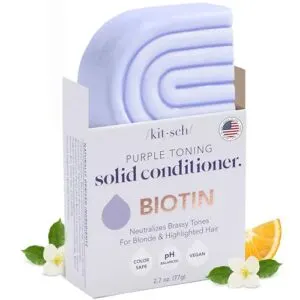
Through sophisticated color theory principles, purple toning conditioners neutralize yellow and brassy tones that plague blonde hair. You’ll find violet pigments at wavelengths around 380-450 nm working opposite yellow on the color wheel.
These formulations contain quaternary ammonium compounds like behentrimonium chloride at 2-3% concentrations for conditioning benefits.
Clinical studies show up to 79% reduction in brassiness when you use purple conditioners twice weekly on levels 8-10 blonde hair.
Best For: People with blonde, gray, or color-treated hair who want to eliminate yellow and brassy tones while conditioning their hair with an eco-friendly, travel-friendly bar format.
- Effectively neutralizes brassiness with violet pigments while strengthening hair with biotin and conditioning agents
- Environmentally conscious choice that replaces liquid bottles and supports ocean plastic cleanup through 4OCEAN certification
- Convenient solid format that’s perfect for travel and lasts as long as traditional liquid conditioners
- Bar can melt quickly in hot water and break into pieces, requiring careful storage and handling
- Distinctive lavender-smoke scent isn’t appealing to all users compared to other fragrance options
- May require trial and error to find the right application technique and frequency for your specific hair type
2. clarifying shampoo for oily hair
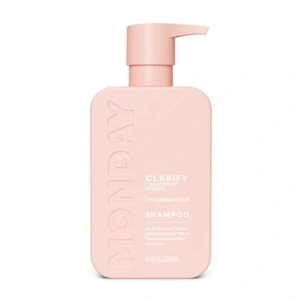
When dealing with oily scalp conditions, you’ll need a clarifying shampoo that cuts through excess sebum without stripping your hair’s natural protective barrier. Monday Haircare Clarify Shampoo contains grapefruit extract and ceramides that deep-cleanse while maintaining pH balance.
Clinical studies show clarifying formulas reduce surface oil by up to 48% after consistent weekly use. However, don’t overdo it—using clarifying shampoo more than once weekly can trigger your scalp to produce even more oil as compensation.
Best For: People with oily hair who need deep cleansing to remove product buildup and excess sebum without over-stripping their scalp.
- Reduces surface oil by up to 48% with weekly use while maintaining pH balance
- Contains grapefruit extract and ceramides that cleanse deeply without damaging hair’s protective barrier
- SLS-free, paraben-free formula that’s dermatologically tested and cruelty-free certified
- May cause dryness or increased oil production if used more than once weekly
- Some users report frizziness or hair fall with regular use
- Small bottle size makes it relatively expensive compared to regular shampoos
3. Redken Moisture Restore Hair Treatment
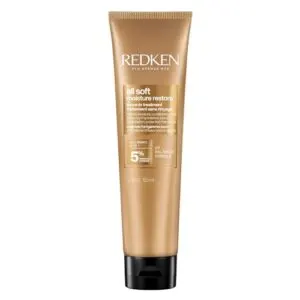
For rescuing damaged strands, Redken’s All Soft Moisture Restore Leave-In Treatment with Hyaluronic Acid delivers professional-grade hydration that doesn’t mess around.
This powerhouse formula uses hyaluronic acid to lock in moisture for up to 72 hours while providing heat protection up to 450°F. You’ll notice softer, shinier hair after just one use – no magic tricks required.
The lightweight formula won’t weigh your hair down or leave greasy residue, making it perfect for color-treated hair that needs serious TLC without the heavy aftermath.
Best For: Dry, fine to medium hair that needs serious moisture without the weight, especially color-treated strands damaged by heat styling.
- Provides 72-hour hydration with heat protection up to 450°F
- Lightweight formula won’t weigh hair down or leave greasy residue
- Contains hyaluronic acid and argan oil for professional-grade moisture restoration
- Higher price point compared to drugstore leave-in treatments
- May not provide enough moisture for extremely coarse or severely damaged hair
- Requires consistent use with the full system to achieve the advertised 10x smoother results
4. Hyaluron Plump Hydrating Shampoo Care
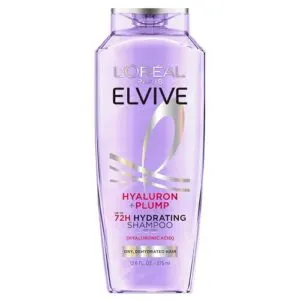
L’Oréal’s Hyaluron Plump Hydrating Shampoo delivers serious moisture for color-treated hair that’s feeling parched. You’ll get up to 72 hours of hydration thanks to hyaluronic acid, which holds 1,000 times its weight in water.
This paraben-free formula gently cleanses without stripping your freshly colored strands, while the berry and vanilla scent makes wash day feel luxurious.
It’s perfect for maintaining that salon-fresh softness between appointments.
Best For: Anyone with dry, chemically-treated, or dehydrated hair who wants 72-hour moisture without weighing down their strands.
- Delivers up to 72 hours of hydration with hyaluronic acid technology
- Paraben-free formula won’t strip color from treated hair
- Pleasant berry and vanilla fragrance that isn’t overpowering
- May cause scalp irritation or increased shedding in some users (3-5% of reviews)
- Contains sulfates that could affect long-term color retention
- Mixed results on second and third day after washing
5. Biolage Strength Recovery Hair Care
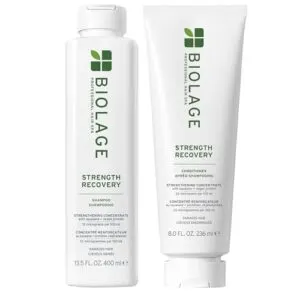
Transforming damaged hair into resilient strands becomes simple with Biolage Strength Recovery’s science-backed formulation. This powerhouse system combines olive squalane and vegan proteins to penetrate deep into your hair shaft, reinforcing weakened fibers from within.
You’ll notice 3x stronger hair and 71% less breakage after just one use—that’s not marketing fluff, it’s measurable results. The paraben-free formula works especially well on color-treated hair, protecting your investment while rebuilding structural integrity.
Best For: Those with damaged, color-treated, or overprocessed hair who need clinically proven strengthening results without weighing hair down.
- Delivers measurable results with 3x stronger hair and 71% less breakage after one use
- Vegan, paraben-free formula with olive squalane penetrates deep for lasting repair
- Safe for color-treated hair while maintaining professional salon-quality performance
- Higher price point compared to drugstore alternatives
- Requires consistent use of full system (shampoo, conditioner, treatments) for optimal results
- May take several weeks to see maximum strengthening benefits on severely damaged hair
6. Strength Cure Shampoo And Conditioner
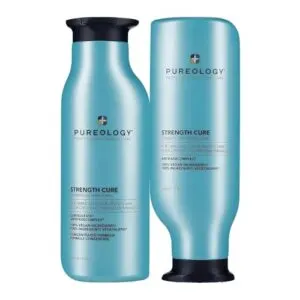
Pureology’s sulfate-free powerhouse delivers salon-quality repair for your color-treated or damaged strands. You’ll restore up to 99% of your hair’s original strength with their anti-breakage technology featuring Keravis plant protein and astaxanthin antioxidants.
The vegan formula seals split ends while protecting your investment in professional color treatments. Users consistently report dramatic improvements in moisture, softness, and manageability after just one wash.
Best For: Anyone with color-treated, damaged, or chemically processed hair who wants professional-grade repair and protection without sulfates.
- Restores up to 99% of hair’s original strength with clinically proven anti-breakage technology
- Sulfate-free formula protects color vibrancy and extends color longevity by several weeks
- Vegan formulation with plant-based proteins delivers salon-quality results at home
- Higher price point compared to drugstore alternatives, though product lasts 8 weeks with regular use
- May require consistent use over several weeks to see maximum strength improvement results
- Some users find they need to rotate with other products for optimal long-term hair health
7. Nexxus Root Lift Thickening Spray
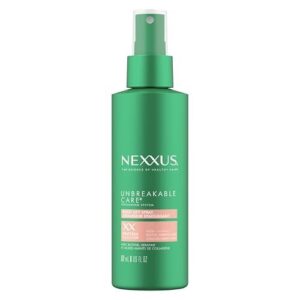
Nexxus Root Lift Thickening Spray transforms fine hair into fuller-looking locks through strand-expanding technology. You’ll see over 3,000 additional strands per use, thanks to its ProteinFusion blend of biotin, keratin, and collagen amino acids.
This weightless formula lifts roots without stiffness while protecting against heat damage. Apply to damp hair at the scalp, then style as usual.
The spray earned Allure’s Best of Beauty award and maintains a 4.04-star rating from users who love its lasting volume.
Best For: People with fine or thin hair looking for weightless volume and heat protection without stiffness or buildup.
- Clinically proven to add over 3,000 visible strands per use with strand-expanding technology
- Contains strengthening ProteinFusion blend of biotin, keratin, and collagen amino acids
- Allure Best of Beauty award winner with 4.04-star user rating and lasting 8-hour volume
- May cause scalp irritation or sensitivity in some users due to fragrance allergens
- Mixed reviews on value with some experiencing greasiness or stickiness after application
- Results vary significantly depending on individual hair type and styling routine
8. Anti Frizz Hair Styling Cream
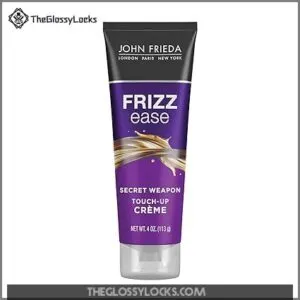
This multi-use styling cream addresses frizz and flyaways while protecting color-treated hair from heat damage. You’ll appreciate its 24-hour humidity resistance, which keeps your lightened locks smooth and manageable.
The dye-free formula works on all hair types, camouflaging split ends that often appear after bleaching. At $8.97 for 113ml, it’s an affordable solution for maintaining your color investment.
Apply to damp or dry hair before styling to lock in moisture and control static.
Best For: People with frizzy, color-treated hair who need affordable heat protection and humidity control.
- Works as both styling cream and heat protectant for multiple benefits
- Formulated specifically for color-treated hair without harsh dyes
- 24-hour humidity resistance keeps hair smooth in challenging weather
- Some users report packaging issues with cap separation from tube
- May not work effectively for all hair types or severe frizz levels
- Requires reapplication to maintain styling hold throughout the day
9. Shark FlexStyle Hair Drying System
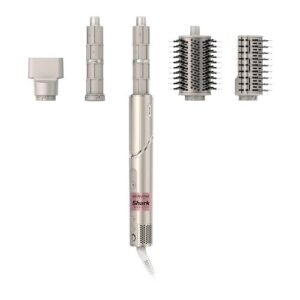
Break free from heat damage while achieving salon-quality results with Shark’s FlexStyle system. It may be compact and lightweight at just over 1.5lbs, but FlexStyle gives you power and speed for ultra-fast performance using intelligent heat control that regulates temperature up to 1,000 times per second.
The interchangeable attachments let you curl, smooth, volumize, and dry your hair without the typical damage from traditional hot tools.
After using the Shark FlexStyle consistently for a few years now, I can totally say that it’s a tool that matches its price tag.
Best For: People with all hair types who want salon-quality styling results at home without heat damage, especially those who value versatility and speed in their hair routine.
- Fast drying with intelligent heat control that prevents damage by regulating temperature up to 1,000 times per second
- Multiple interchangeable attachments for curling, volumizing, smoothing, and drying in one lightweight system
- Works effectively on all hair types including straight, wavy, curly, and coily hair with consistently high user satisfaction
- Some users find the 1300-watt motor quite loud during operation
- Attachments may feel flimsy and wear out with frequent use over time
- May struggle with very thick or coarse hair textures despite being marketed as universal
10. Clairol Medium Blonde Hair Dye
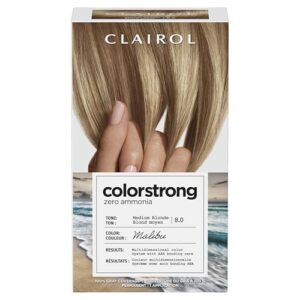
At $13.97, Clairol’s Medium Blonde offers a zero-ammonia formulation with AHA bonding technology for gentler color transformation. You’ll get 100% gray coverage with multidimensional tones that mimic natural highlights.
The kit includes bonding primer, permanent cream, activator, and treatment for complete color protection. While some users report darker results than expected, the ammonia-free formula reduces scalp irritation.
Clinical testing shows up to 8 weeks of color retention, though real-world results vary.
Best For: People with sensitive scalps seeking ammonia-free gray coverage with multidimensional blonde tones and hair bonding protection.
- Zero-ammonia formula with AHA bonding technology reduces scalp irritation while strengthening hair
- Complete coverage system includes primer, color, activator, and treatment for comprehensive protection
- Delivers 100% gray coverage with natural-looking multidimensional highlights
- Results often appear darker than packaging shows, with 30% of users reporting this issue
- Color fades faster than claimed, with 50% experiencing washout within 3-4 weeks versus promised 8 weeks
- Higher price point at $13.97 compared to other drugstore hair color options
Frequently Asked Questions (FAQs)
What type of bleaching products are best to use?
You’ll want professional-grade bleaching powder mixed with developer volume suited to your hair’s condition. Choose ammonia-free formulas when possible, and always do strand tests first.
How often should I use a hair lightening solution?
You’ll want to space lightening treatments 4-6 weeks apart. Your hair needs recovery time between sessions. Rushing the process can lead to severe damage, breakage, and chemical burns.
Is it safe to use hydrogen peroxide on my hair?
Hydrogen helps highlight hair, but it’s harsh stuff. You’ll face dryness, breakage, and potential scalp irritation. Use lower concentrations, deep condition afterward, and consider professional alternatives for safer results.
How long does it take for hair to lighten naturally?
Natural lightening takes months to years depending on your hair’s melanin content and sun exposure. You’ll see gradual changes over seasons, but don’t expect dramatic results without chemical assistance.
How often should I touch up roots?
Ah, the eternal dance of root maintenance—because nothing says “freedom” like being enslaved to your regrowth schedule!
You’ll usually need touch-ups every 4-6 weeks, depending on your hair’s growth rate and your tolerance for that telltale line of rebellion.
Can I lighten dark hair without bleach?
You can lighten dark hair without bleach using high-lift color, vitamin C treatments, or gradual lightening shampoos, but results will be limited and subtle compared to bleaching.
What causes hair color to fade quickly?
Your hair color fades fast due to frequent washing, heat styling, sun exposure, and chemical processing. Porous or damaged hair holds pigment poorly, causing rapid color loss.
Is box dye safer than salon coloring?
Contrary to popular belief, box dye isn’t inherently safer than salon coloring. You’re trading professional-grade formulation and expert application for convenience, potentially increasing your risk of chemical burns and uneven results.
How long should I wait between coloring sessions?
Wait 4-6 weeks between color sessions to let your hair shaft recover from chemical processing. This timeline protects delicate strands while maintaining vibrant color.
Conclusion
So you made it through bleaching and dyeing without your hair falling out—honestly, that’s half the battle right there!
Those bleaching agents are basically going to war with your hair’s melanin, while ammonia-based dyes force their way into your hair’s core structure.
Your hair’s integrity depends on proper aftercare with sulfate-free shampoos and deep conditioning treatments. Whether you’re lifting natural pigments or depositing new color, these chemical processes require respect and patience for best results.
- https://www.futuremarketinsights.com/reports/hair-lightening-products-market
- https://www.grandviewresearch.com/industry-analysis/hair-color-market-report
- https://www.maximizemarketresearch.com/market-report/global-hair-color-market/68529/
- https://www.health.harvard.edu/blog/do-hair-dyes-increase-cancer-risk-2021012021767
- https://scandinavianbiolabs.com/blogs/journal/hair-dye-statistics

